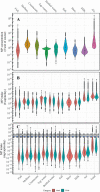Lifetime Accumulation of Microplastic in Children and Adults
- PMID: 33724830
- PMCID: PMC8154366
- DOI: 10.1021/acs.est.0c07384
Lifetime Accumulation of Microplastic in Children and Adults
Abstract
Human exposure to microplastic is recognized as a global problem, but the uncertainty, variability, and lifetime accumulation are unresolved. We provide a probabilistic lifetime exposure model for children and adults, which accounts for intake via eight food types and inhalation, intestinal absorption, biliary excretion, and plastic-associated chemical exposure via a physiologically based pharmacokinetic submodel. The model probabilistically simulates microplastic concentrations in the gut, body tissue, and stool, the latter allowing validation against empirical data. Rescaling methods were used to ensure comparability between microplastic abundance data. Microplastic (1-5000 μm) median intake rates are 553 particles/capita/day (184 ng/capita/day) and 883 particles/capita/day (583 ng/capita/day) for children and adults, respectively. This intake can irreversibly accumulate to 8.32 × 103 (90% CI, 7.08 × 102-1.91 × 106) particles/capita or 6.4 (90% CI, 0.1-2.31 × 103) ng/capita for children until age 18, and up to 5.01 × 104 (90% CI, 5.25 × 103-9.33 × 106) particles/capita or 40.7 (90% CI, 0.8-9.85 × 103) ng/capita for adults until age 70 in the body tissue for 1-10 μm particles. Simulated microplastic concentrations in stool agree with empirical data. Chemical absorption from food and ingested microplastic of the nine intake media based on biphasic, reversible, and size-specific sorption kinetics, reveals that the contribution of microplastics to total chemical intake is small. The as-yet-unknown contributions of other food types are discussed in light of future research needs.
Conflict of interest statement
The authors declare no competing financial interest.
Figures




References
-
- Presence of Microplastics and Nanoplastics in Food , with Particular Focus on Seafood EFSA Panel on Contaminants in the Food Chain ( CONTAM ). EFSA J. 2016, 14, e04501.10.2903/j.efsa.2016.4501. - DOI
-
- Peixoto D.; Pinheiro C.; Amorim J.; Oliva-Teles L.; Guilhermino L.; Vieira M. N. Microplastic Pollution in Commercial Salt for Human Consumption : A Review. Estuar. Coast. Shelf Sci. January 2018, 219, 161–168. 10.1016/j.ecss.2019.02.018. - DOI
Publication types
MeSH terms
Substances
LinkOut - more resources
Full Text Sources
Other Literature Sources

